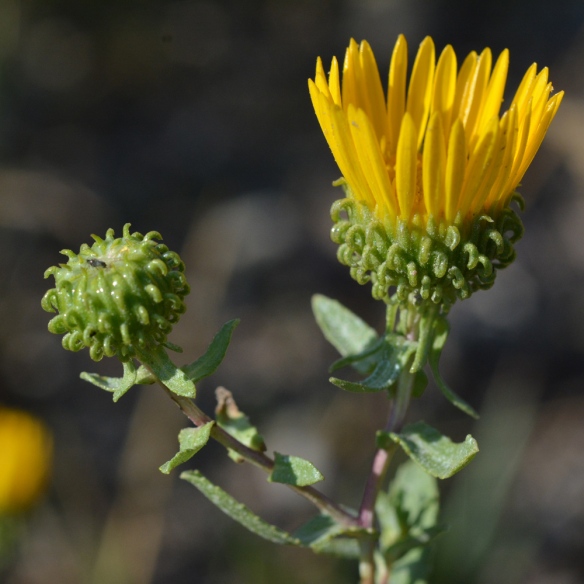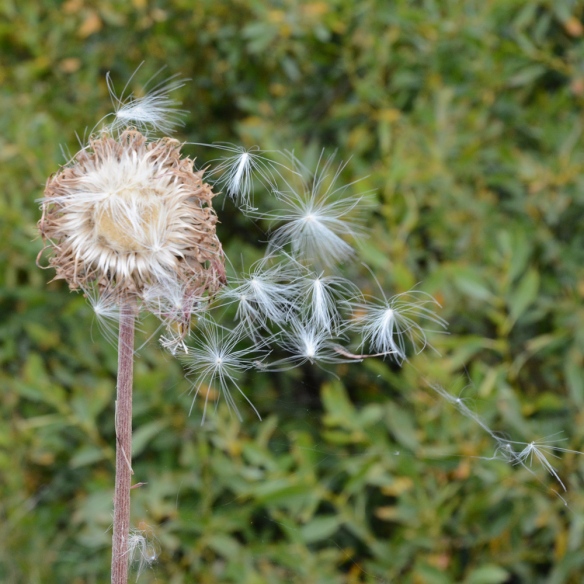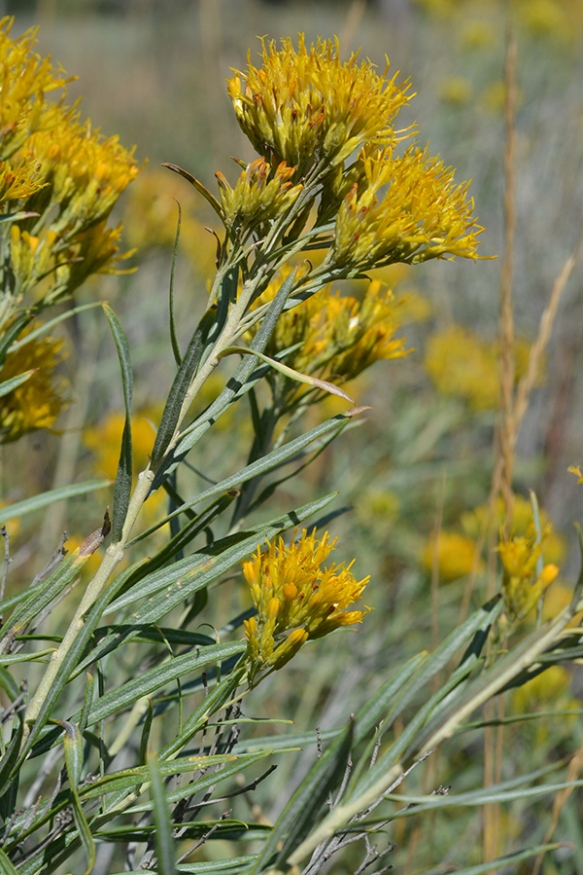A variety of composites – members of the Aster Family (Asteraceae) – have been in bloom since the beginning of August, and many continue to bloom into the end of the month. Composites are at their flowering peak when most insects are also at the climax of their annual life cycles. For instance, butterflies have developed from eggs to larvae to chrysalises to beautiful adults over the course of the summer. They depend on nectar in their final days. These and many other insects are laying eggs in host plants for another year. August is a great time to look at both flowers and insects!

(Photo of Fritillary on Rubber Rabbitbrush by Susan Marsh)
As some of you already know, the Aster family is one of the largest plant families in the world. The basic characteristic of the family is that many individual flowers are gathered together on a platform and surrounded by protective bracts to form a “head” that looks like a single flower—a “composite” flower.

(Image from: https://cronodon.com/BioTech/asteraceae.html)
From this simple flower “plan”, the variations multiply. The 5-parted flowers can be “ray” flowers with their petals fused into a single showy petal-like structure, or less obvious “disc” flowers with the petals fused into a tube. Heads can have a combination of both ray flowers and disc flowers, or all disc or all ray flowers and come in various sizes and colors. The surrounding protective bracts are helpful ID features and fruits have distinctive dispersal mechanisms, as well.

Ecologically, members of the Aster Family offer an abundance of nectar and pollen in one location over an extended period of time: individual flowers boom and fade sequentially. Also, the often wide-open arrangement enables many different insects to land and probe, dab, lap, and suck nectar and gather pollen accidentally or on purpose before they seek more rewards on the next similar flower. Insects munch on developing or ripened seeds, lay their eggs in flowers or stems, and otherwise make use of these often abundant plants. Birds and small rodents are common dispersers of the fruits.
With this introduction, here are some common composites that have been blooming for the past couple of weeks. We have provided some ID tips to help you look more closely.
Showy Goldeneye – Vigueria multiflora – has several cheerful yellow flower heads waving about on thin 2-3’ stems adorned with oblong opposite leaves. If you look, you will see that there is a shift in hue from a lighter yellow to a darker tone toward the center of the “golden eye”. Insects with their UV vision likely see this as a distinct bulls-eye. Showy Goldeneyes are common along park roadsides and into dry meadows.

Curleycup Gumweeds – Grindelia squarrosa – are sturdy, dense, foot-high plants found along park roads. The bright-yellow, almost glowing, flower heads have distinctive sticky bracts which curl under.

You are likely to smell Tarweed – Madia gomerata – before you see it. An acrid odor arises from around your feet where you have stepped on it. You may wonder. “Where are they paving the road?” Usually only a few inches high (although I have seen it 18” tall), these resinous plants have tiny oily hairs and small linear leaves. Heads have only a couple of ray flowers. This annual is mostly in disturbed sites and is considered a native weed.

Western Coneflower – Rudbeckia occidentalis – grows to 4-6’ high. The large oval to triangular leaves can reach 10” long and alternate up sturdy straight stems. At the top are brown-black “cones” surrounded by a collar of green bracts. The “cone” is the “receptacle” or platform for the many tiny disc flowers. Flowers start blooming from bottom—look for the yellow pollen, and spiral up over a couple of weeks to the top. These tiny flowers attract dozens of pollinators! In one large meadow with thousands of coneflowers, I witnessed bees on one-in-20 cones, often more than 1 bee/flower head, and myriad Milbert’s Tortoiseshell butterflies, all gathering pollen and nectar from these abundant “disc” flowers. Later Pine Siskins and other birds will pluck out the seeds. Again, it is likely the flowers project a UV signal that our human eyes cannot detect.

Rayless Arnica – Arnica parryi – is also composed of only “disc” flowers, unlike its much more admired relatives which have showy heads of both ray and disc flowers. Note the bracts are even in size and the leaves are opposites, as in all arnicas.

Canada Goldenrod – Solidago canadensis – is perhaps one of the most important flowers for biodiversity in the U.S. according to Dr. Doug Tallamy of the University of Delaware*. Abundant from East to West, the 2-3’ flowers colonize large areas. Here they spread best in relatively moist soils. By mid-August, they produce hundreds of tiny yellow flower heads that attract pollinators of all sorts. Other insects burrow into the stems to over-winter or lay eggs. Many birds depend on the bugs for their nutrition.

Goldenrod is not responsible for our allergies: Their showy flowers have evolved to attract insects to deliver the heavy pollen. However, often unseen nearby are plants that rely on wind to disperse pollen—such as grasses and soon sagebrush. Wind-dispersed pollen is much lighter and can lodge in nostrils and eyes.
Oregon Daisy – Erigeron speciosus – is one of a few showy blue daisies (vs asters below) that bloom into late summer. Typically, Erigerons have many, often narrow, ray flowers surrounding many yellow disc flowers. Even-sized bracts ring the flower heads like a palisade fence. One- to three-inch oval leaves alternate up the stem. These plants are showy and sturdy enough to be good garden plants!

Leafybract Aster – Symphyotrichum foliaceum/cusickii – is 1-3’ tall, has large alternate leaves which can be 4-6” long near the base, smaller near the top. The blue flower heads are surrounded by “leafy” bracts of different sizes which are arranged roughly like shingles on a roof. This species comes in various varieties, but here we group them as one.

Pacific Aster – Symphyotrichum ascendens – is a tough 1-2’ plant that seems to thrive along roadsides.

The light-blue flower heads have tidy bracts that look like well-placed shingles. The narrow leaves have veins that form elongate patterns which help determine this particular species.

Engelmann Aster – Eucephalus engelmannii – is readily identified by its 4-5′ stems cloaked by alternating 4-6” leaves that retain their size as they spiral up the stem.

The large white flower heads are surrounded by a distinctive set of bracts. This is a very common plant in aspen groves and higher elevation meadows.

Thickstem Aster – Eurybia integrifolia – thrives from sagebrush flats in the valley floor up to 9,000’ subalpine meadows. Stems are not only thick and sticky but have a bit of a zig-zag at the nodes where each leaf alternates up the stem. Deep purplish-blue flowers are protected by hefty protruding bracts covered by sticky hairs. All sorts of insects come in to pollinate them and others try to eat them…sometimes getting stuck in the forest of glutinous hairs.

Musk Thistle – Carduus nutans – is a monster of a composite. This invasive exotic can grow up to 7’ tall sporting multiple stems with elongate lobed leaves, all armed with ferocious spines. However, it is hard not to admire the 2+” flower heads for their gorgeous color. Insects galore come to gather pollen and nectar. And recently I have witnessed pine siskins and a downy woodpecker relish the fruits.

Each fruit (technically an “achene”–a dry case with one seed inside – like a sunflower seed) is attached to a sail of fluff. Hundreds, thousands, of fruits are dispersed by the wind, seeding into pastures and along trail edges, where new plants sprout up quickly to outcompete our natives. USDA has designated musk thistle a noxious weed. Our local Teton County Weed and Pest https://www.tcweed.org/ can help land owners control it on their property.

Rabbitbrushes lure myriad butterflies, bees, and flies at the end of the growing season when nectar and pollen supplies are shriveling up. Both species do well on dry, often disturbed sites such as roadsides, construction sites, and cliff edges.
Rubber Rabbitbrush – Ericameria nauseosa – has a white sticky sap that has been investigated as a form of rubber—hence its common name. “Nauseosa” likely comes from the very strong fragrance and taste of broken twigs. Twigs are typically covered in a layer of fine white hairs – tomentum – and are rather flexible. Leaves are very narrow up to 4” long on shrubs that can be 2-4’ high and wide. The many elongate disc flowers attract a hubbub of late summer pollinators.

Douglas Rabbitbrush – Chrysothamus viscidifolus – is best identified by its twisted leaves with resinous or “viscid” glands.

The stems do not have hairs. It comes in several varieties, but this is the most common one I have seen. Typically shrubs are only a foot or so high.

While most of these flowers will be fading in color, another composite is just beginning to bloom–Sagebrush! However, their flowers are wind-pollinated and, therefore, often go unnoticed.
Many of these same flowers and more are featured on past Teton Plants posts. Look into the TetonPlants.org archives for more images and info.
Enjoy botanizing!
Frances Clark, Wilson, WY
P.S. As always we appreciate any corrections or suggestions. Email us at tetonplants.org for your comments and to be placed on our email list.

Thank you Frances for the amazing photos, thorough details and sharing your love for flowers and plants. I saw many bees feasting on coneflowers yesterday! I also enjoyed seeing many deep, red berries and the mountain ash. Thank you for the rayless arnica info, I look forward to identifying it in the near future.
Thanks, Frances! I have been learning so much from these posts.
Wonderful blog. But please identify the lovely butterfly with black bordered fore and hind wings in the uncaptioned photo. My husband and I saw a multitude of them on a hike this past Tuesday. It doesn’t match the photos of the Milbert’s tortoiseshell’s I have found, but does appear similar to the photos of California tortoiseshells, whose range is indicated as extending to western Wyoming.
We are stumped. Thank you for all of the other great information!
Thanks for the lesson on composites. We are now in Boise so we don’t get to seen you any more but the lesson is still appropriate.
I enjoy my botany lessons. You are so thorough. Thank you!